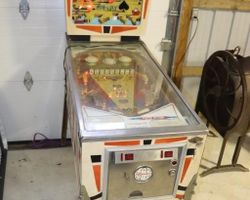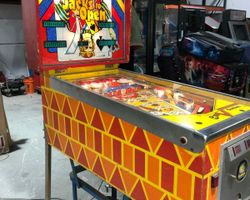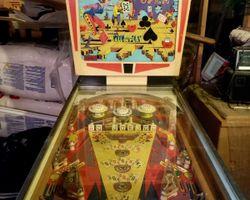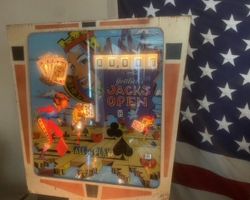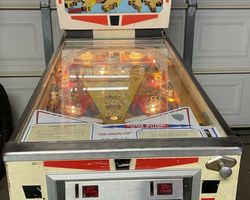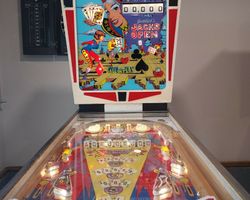Jacks Open
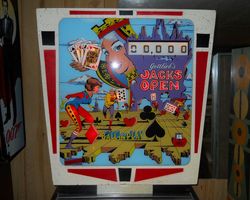
Average Prices: USD $700 to $2,200
Produced: January, 1977
Production Run: 2,975 units
Machine Type: Electro-mechanical
Players: 1
Design by: Ed Krynski
Art by: Gordon Morison
The Jacks Open pinball machine, released in February 1977 by D. Gottlieb & Co., represents a distinctive high point in electro-mechanical (EM) pinball design. Crafted at a time when the industry was on the cusp of transitioning to solid-state technology, this machine masterfully combined established EM principles with an innovative rule set, securing its place as a collector’s favorite and a compelling example of Gottlieb’s late 1970s output.
History and Background
Jacks Open emerged from the Gottlieb factory in January 1977, hitting the market in February of that year. Bearing the model number 395, it was a creation of the skilled Gottlieb team, with Ed Krynski responsible for the design and Gordon Morison for the artwork. The machine embraced a card and gambling theme, specifically focusing on poker hands, a concept that would become central to its innovative gameplay. With 2,975 units produced for both domestic and export markets (1,949 domestic, 1,026 export), plus an additional 113 sample games in late 1976, Jacks Open saw a production run totaling 3,088 units. This volume reflects its anticipated appeal to operators, who could acquire the machine for an estimated $965 FOB Chicago in early 1977.
An interesting facet of Jacks Open's production history involves its playfield material. While many Gottlieb playfields from this era were plywood, some Jacks Open units featured chipboard playfields, identifiable by white paint in the flipper "swipe" area and along the upper ball arch—areas typically unpainted on plywood versions. This variation was a direct response to a spike in plywood prices, demonstrating Gottlieb's adaptability in material sourcing during production. Jacks Open also spawned a sister game, "Lucky Hand," an Add-a-Ball (AAB) version for markets where replay features were restricted, which was also exported to Italy as "Lucky Card." Its design legacy later saw a reimagining in Mylstar's 1984 solid-state machine, "Jacks to Open."
Signature Features and Design
The design of Jacks Open is characterized by a focused set of features that work in concert to create a cohesive and engaging experience. Its most prominent mechanical element is the central bank of nine drop targets, which are the heart of the game's objective. Unlike many EM machines, Jacks Open notably omits slingshots, a deliberate design choice that significantly alters ball trajectory and control, demanding greater precision from the player. Instead, it features three pop bumpers that provide chaotic, yet controlled, ball movement.
A unique design element is the "open-elbow" inlanes, which allow the ball to pass between inlane and outlane with less predictability. This feature contributes to the game’s reputation for challenging ball control. The machine also features a traditional wedge-head cabinet, standard for Gottlieb at the time, housing mechanical score reels that display a maximum score of 199,990 points.
Gordon Morison's artwork for Jacks Open is a standout component. The backglass is particularly noted for its attractive, interesting, and colorful depiction of a poker scene, immediately setting the game’s theme. While the playfield art is sometimes described as less spectacular than the backglass, its functional layout and clear "Shoot For" inserts guide the player efficiently through the game’s progression, reinforcing the poker hand objective. The integration of the card theme into the very mechanics of play—requiring players to complete "hands" of drop targets—is a clever design choice that elevates the entire experience.
Playfield and Mechanics
The playfield layout of Jacks Open is deceptively simple, yet it facilitates complex and demanding gameplay. Two flippers guard the drain, positioned with a wider gap than seen on some contemporary machines, contributing to the game's challenging nature. Above the flippers, the "open-elbow" inlanes are a constant source of unpredictable ball movement, requiring players to react swiftly and adapt their control strategies. Three pop bumpers are situated strategically, creating a lively upper playfield area where the ball can careen, setting up unpredictable shots toward the central target bank.
The core of the playfield is dominated by the nine drop targets. Arranged in a bank, these targets are the primary objectives for players seeking to advance through the game. Above this bank are a set of top rollover lanes, which are crucial for maximizing scoring potential, as they enable higher target values when three out of four are lit. The absence of slingshots means rebounds from the lower playfield are less direct and more reliant on flipper nudges and precise timing, demanding a different kind of finesse from the player.
The visual aesthetic of the playfield, while perhaps less ornate than the backglass, is functional and clear. The "Shoot For" inserts, illuminated as the game progresses, effectively communicate the current objective, guiding the player to focus on specific drop targets. The overall design philosophy emphasizes direct, challenging shots at the drop targets, with the surrounding elements designed to test a player's ability to maintain control in a fast-paced environment. The lighting, characteristic of EM machines, highlights key targets and score progress, enhancing player immersion in the game’s card-themed progression.
Gameplay Dynamics
Jacks Open distinguishes itself with a deep, progressive gameplay system centered around completing poker hands. The objective is to light up and clear specific sets of the nine drop targets, advancing through a "progression ladder" of hands: "2 Jacks," "3 Queens," "Full House," and "Royal Flush."
In a standard 5-ball game, play initiates with the "2 Jacks" targets lit. Successfully hitting these targets resets the entire bank of nine drop targets, and the game progresses to the next hand. This immediate reset, a hallmark of Jacks Open, provides a satisfying sense of accomplishment and keeps the action flowing. The most coveted objective is the "Royal Flush." Achieving this by hitting the five red A-K-Q-J-10 drop targets not only resets all targets but triggers a unique drop target trip arm mechanism. This arm immediately drops the four black Q-J-K-Q targets, leaving only the five red targets standing. Successfully clearing these remaining five red targets awards an "All Targets Down Special."
For 3-ball play, the game provides a slight advantage by spotting the two Jack drop targets, allowing play to begin with the "3 Queens" lit. Similar to 5-ball play, after the "Full House" is scored and the bank resets, the trip coil immediately drops the four black targets, setting up the "All Targets Down Special" from the remaining red targets. A crucial and highly addictive mechanic of Jacks Open is that after scoring a Special, all nine drop targets reset, and the four black targets are immediately dropped again. This leaves only the five red targets, allowing players to potentially score consecutive Specials until the game concludes, providing a powerful incentive for replay.
Beyond the target progression, strategy involves utilizing the top rollover lanes. Lighting three of these four lanes significantly increases the value of the drop targets, rewarding skilled players who can consistently hit these upper playfield objectives while simultaneously working on their poker hands. The wide flipper gap and open lanes demand precise shooting and reactive play, as ball cradling is difficult, forcing players to focus on continuous, accurate shots rather than sustained control.
Reception and Legacy
Jacks Open is widely regarded as one of Gottlieb's most compelling electro-mechanical pinball machines, frequently cited as a must-have for collectors and a standout from the late 1970s EM era. Its overall sentiment is overwhelmingly positive, described as highly addictive, challenging, and remarkably well-designed, especially for those who appreciate drop target-centric gameplay. Despite its apparent simplicity, players consistently find significant depth and replayability, often leading to a "one more game" experience.
The machine's strengths are numerous. Its addictive nature stems directly from the engaging and progressive rule set, where clearing poker hands is both clever and deeply rewarding. The consistent reset of the drop targets after completing a hand is a particular highlight, maintaining a satisfying rhythm of play. Players laud its challenging but fair shots, which demand precision and skill, contributing to the game's high replay value. The large central bank of drop targets is universally praised as the game's defining and most well-executed feature. While the backglass artwork by Gordon Morison is often described as attractive, interesting, and colorful, some opinions suggest the playfield art is less spectacular or a bit plain, though this rarely detracts from the overall experience.
The unique ball control elements—specifically the "open" lanes and the wide gap between the flippers—are frequently mentioned. While some players find these features a source of frustration due to the difficulty in cradling the ball and the unforgiving nature of sloppy play, many enthusiasts consider them a testament to the game's challenging design, forcing adaptation and precision. The strategic nuances, such as utilizing the top rollover lanes to maximize target values, reward skilled play and add layers to the scoring potential. The "Special" award is a powerful hook, often seen as a significant achievement that keeps players invested. For many, Jacks Open evokes a strong sense of nostalgia, cementing its status as a classic.
However, Jacks Open is not without its minor criticisms. Its desirability means that finding a machine in good condition can be challenging. Beyond the playfield art, a few players have noted a limited variety in scoring paths (though this is often outweighed by the depth of the primary mechanism) and the absence of a prominent bell sound.
Jacks Open's legacy is robust. It stands as a pinnacle of EM design, particularly showcasing Gottlieb's mastery of the format just before the widespread adoption of solid-state technology. Its innovative drop target progression and unique ball control elements certainly influenced later designs, even those in the solid-state era. The enduring appeal of its core gameplay led to its add-a-ball counterpart, Lucky Hand, and a later solid-state remake, underscoring its timeless and influential design. It remains a cherished piece of pinball history and a sought-after machine for collectors worldwide.
Sponsored Links
 Ebay Listings
Ebay Listings
 Auction Results
Auction Results
| Cost | Location | Date |
|---|---|---|
| USD $1,850 |  California, United States California, United States |
26 March, 2025 |
| USD $1,800 |  Maryland, United States Maryland, United States |
17 October, 2024 |
| USD $1,800 |  California, United States California, United States |
23 October, 2023 |
| USD $2,700 |  Georgia, United States Georgia, United States |
23 August, 2023 |
| USD $875 |  Maryland, United States Maryland, United States |
14 April, 2023 |
| USD $2,500 |  Florida, United States Florida, United States |
19 February, 2023 |
| USD $2,675 |  Florida, United States Florida, United States |
14 February, 2023 |
| USD $1,500 |  Texas, United States Texas, United States |
13 July, 2022 |
| USD $1,500 |  Texas, United States Texas, United States |
02 July, 2022 |
| USD $1,200 |  Maryland, United States Maryland, United States |
15 June, 2022 |


Private Policy · Search Website · Contact Us
As an eBay Partner, we may earn a commission from qualifying purchases made through links on this site, at no additional cost to you.
All trademarks and copyrighted materials remain property of their respective owners. All other content copyright 2007 - 2025 Pinpedia.

